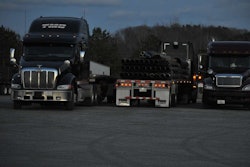
2. Fair play
The success of any rewards or incentive program depends on drivers’ perception of the game. Drivers might be skeptical of a fuel incentive based solely on mpg because many factors such as equipment and routes are beyond their control.
 XRS plans to release a new social network, X Nation, where drivers can create competitions and share performance with peers.
XRS plans to release a new social network, X Nation, where drivers can create competitions and share performance with peers.Neutralizing the impact of heavy versus light loads, highway versus city mileage, equipment and other factors creates a significant data challenge, says Schrier, explaining why Covenant has not offered a fuel incentive program – at least not yet. Drivers also might feel that fuel incentives have an opportunity cost; slowing down to increase mpg could decrease their mileage and pay.
None of these factors seem to hinder the results of the mpg incentive program created by Mesilla Valley Transport, which boasts one of the country’s highest mpgs among fleets. Several years ago, the Las Cruces, N.M.-based truckload company began offering a Harley Davidson every quarter to the driver with the highest mpg. Besides the grand prize winner, all drivers who are above the company’s target mpg each quarter receive a cash bonus.
Because MVT drivers slip-seat vehicles, getting accurate mpg readings required some work. Mike Kelley, director of information technology, created a way to use drivers’ dispatch data to query the mpg data – vehicle unit, date and time – from its PeopleNet onboard computing and mobile communications system. MVT now has a database of mpg by driver regardless of what vehicle they drive and when.
Every week, MVT sends an automated message to each driver that shows them their mpg ranking. Drivers see where their mpg ranks in their group and in the overall fleet. To qualify for the grand prize and the bonus, drivers also must have a clean compliance record and accept all loads given to them.
One of the advantages of using FuelOpps is that it creates a level playing field for a fuel incentive. The database uses algorithms to measure and benchmark fuel performance in an intuitive way for drivers. Through the online interface, drivers only see the categories of mpg they control directly, such as acceleration, shifting and cruising.
FuelOpps shows drivers their rating by category using a horizontal scale from 1 to 10, as well as their overall FuelOpps rating. While Covenant probably has the IT resources to create a similar type of fuel program, “it would take us forever,” Schrier says.
Erb Group, a temperature-controlled carrier based in New Hamburg, Ontario, created a driver incentive program that uses three metrics: idling, speed and hard braking. Drivers directly control these behaviors, says Tom Boehler, director of safety and compliance.
The metrics are taken directly from the vehicle’s ECM through Turnpike, a small in-cab wireless device from XRS Corp. By collecting data from every vehicle, the Turnpike system calculates drivers’ scores for each metric, as well as an overall score, as a percentile.
Drivers see their score and how they compare to the rest of the fleet when they log in to the company’s safety website to access training videos, policies and procedures.
Every quarter, drivers above the 78th percentile receive a bonus of 0.4 percent of their quarterly earnings. The scale increases to a maximum of 2.0 percent of earnings for drivers that score at least 97 percent. Erb Group also gives its owner-operators a quarterly bonus; those with a score of 97 percent or above for speed and hard braking get a reduction on their insurance premium for the next quarter.
3. Hands-off approach
Another useful benefit of technology is being able to engage drivers in a rewards program without having to administer it.
 Using its cloud-based software, Equinox extracts information from fleets and provides owner operators with performance information through a mobile app.
Using its cloud-based software, Equinox extracts information from fleets and provides owner operators with performance information through a mobile app.The FuelOpps program is completely hands-off for fleets. Besides providing the FuelOpps user interface, the service includes one-on-one fuel coaching for drivers and custom fuel tips. Covenant drivers receive these messages through the company’s Qualcomm in-cab communications platform.
“We can focus on the important things like servicing clients, making a happy environment for drivers and delivering a safe product,” Schrier says.
FuelOpps has an optional catalog system if fleets want to allow drivers to redeem their points for merchandise rather than have their own rewards for fuel conservation. Fleets pay for the points only when drivers redeem them.
“We handle everything,” says Yunsu Park, chief technology officer of Propel IT. “We also interact with drivers directly on an ongoing basis.”
Fleets using the Stay Metrics program upload a spreadsheet-style report for each of their chosen rewards categories – mpg, accident-free miles, clean inspections, etc. – with drivers’ results updated on a regular basis. Stay Metrics manages all other manual aspects of the rewards program, such as fielding calls from drivers and training them to use the website.
Drivers log in to check their points balance, watch safety videos, view announcements and answer questions and surveys. They receive an e-mail notification each time points are added as well as monthly summaries.
Stay Metrics also monitors site usage. If the percentage of the fleet that logs in each week drops, it will work with companies to make a marketing push.
Having an automated rewards program also can reduce administrative costs for other processes such as driver training and communications. ProFleet holds quarterly safety meetings, but drivers who can’t attend can read the meeting notes online on the Drive for Gold website.
Gregory also posts safety quizzes on the website for drivers to earn points. “Drivers get on and take the quizzes and discuss it with others,” he says. “These things create communication and teamwork, and drivers walk away with something.”














